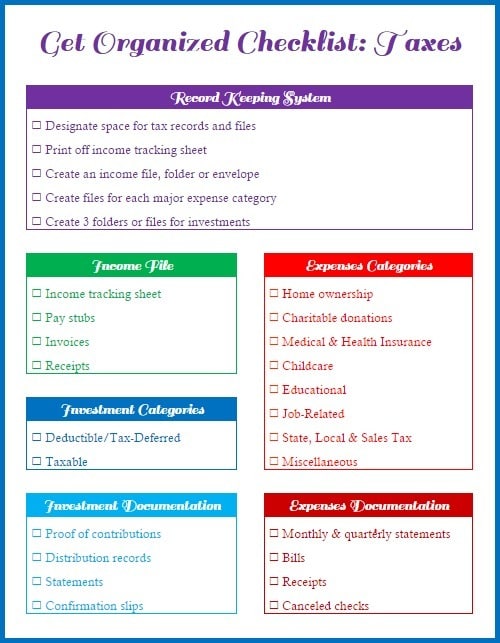The start of a New Year is the perfect time to establish a tax record keeping system. This Get Organized Checklist for Your Taxes will walk you through a simple process to set up your system.
This checklist is part of the Get Organized series. Each week I’ll be sharing a new checklist to help you organize one specific area of your home or life. Last week I shared my Get Organized Checklist for your Command Center.
How to Set up Your Tax Record System
The key to reducing your tax bill each year is to have a good system in place all year. For individuals, our tax year runs in conjunction with the calendar year so the start of a new year is the perfect time to set up your system. Here’s a simple Orstrategy.
Designate a Space
First, figure out WHERE you’re going to store all of your tax documents. It can be a drawer in your file cabinet, an accordion file at the kitchen desk, or even a portable file box in the corner of your closet if that’s your preference. Just make sure it’s easily accessible and convenient so that you don’t end up putting off filing paperwork due to inconvenience.
Create an Income Record
One of the biggest mistakes you can make on your taxes is failing to claim income that ends up being reported to the IRS. One year my W-2 was mailed to the wrong address and I almost forgot to claim several thousand dollars in income.
Your record can be a simple piece of notebook paper. Or, you might prefer to use this Income Tracking Sheet I created. Just make sure you record EVERY piece of income you receive (e.g. wages, tips, jury duty pay, gambling winnings, etc.). Come tax season, you can simply check off items as the tax documents arrive in the mail.

Create Files for Income, Expenses and Investments
Files are the most traditional way to organize your tax files, but you can also use folders or envelopes. Again, it’s more important to choose whatever is most comfortable for you.
You’ll put your income tracking sheet inside the income folder. Then, throughout the year, you’ll add any documentation for income you receive (e.g. bank statements, pay stubs, receipts).
For expenses, you’ll likely need multiple files or folders. If you itemize, it’s a good idea to have one file for each major deduction category:
- Home ownership
- Charitable Donations
- Medical expenses
- Health insurance
- Childcare expenses
- Educational expenses
- Job-related expenses
- State, local and sales tax
- Miscellaneous
You can omit files for any categories you know you won’t incur expenses for (e.g education if no one in the family will be taking college courses or attending private school). Throughout the year add receipts, bills, statements, and canceled checks for expenses to the correct file.
In similar fashion, I recommend setting up two files for your investments:
- Deductible/tax-deferred investments
- Taxable investments
You’ll file your statments and confirmation slips in the appropriate investment file.
Use the printable checklist below to mark off each part of the system as you set it up.
Printable FAQs
Fill in the form above. After you submit the form, you’ll receive an email from “Wondermom Wannabe” with a direct link to the printable. If you do not see the email in your inbox within a few minutes, check your spam folder.
The most likely place will be in your computer’s Downloads folder. You can also select “Downloads” in your browser menu to see a list of your downloads, then simply select “Show in folder” below the file name to see where it is stored on your computer.
You’ll need a program that supports PDFS, like Adobe Acrobat (which is free). Open the program, click File > Print. Select your printer and set the number of copies you want to print. Double check your print preview, then click print.
How to Organize Your Documents to Prepare Your Taxes
If you follow the system outlined above, you’ll have all the documentation you need (aside from the forms that will come in the mail during tax season) to minimize your tax bill.
Because my focus was on helping you set up your system, not on gathering specific documents for tax preparation, you won’t find a detailed list of those documents here. You can, however, print a complete list of those documents here.


